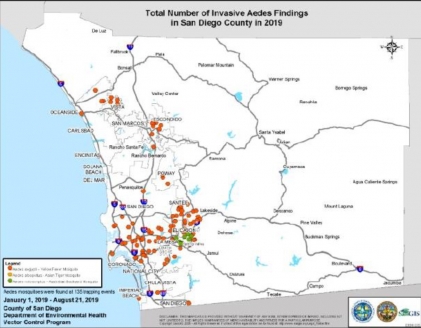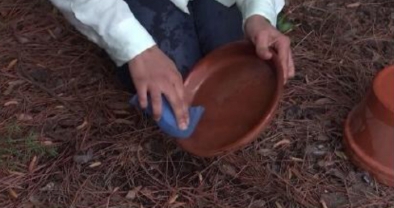 County asks public’s help to report and eradicate invasive mosquitos that can transmit dangerous diseases including Yellow Fever and Zika
County asks public’s help to report and eradicate invasive mosquitos that can transmit dangerous diseases including Yellow Fever and Zika
By Miriam Raftery
August 28, 2019 (San Diego) – Lakeside resident Dennis Richardson was appalled to discover that “thousands” of Yellow Fever mosquitos were breeding in water dishes under potted plants at his home. His grandfather was a sanitation engineer who worked to eradicate Yellow Fever so that Americans could build the Panama canal and later battled a Yellow Fever epidemic in Peru. Richardson says, “This work was deadly for most who did the work, as most got yellow fever.”
Yellow Fever is fatal 20 to 50 percent of the time. It’s most obvious symptom is yellow eyes and skin (jaundice). Fortunately, this disease is not present here, but could take hold if one of these mosquitos were to bite a returning traveler with the disease. In the past, Yellow Fever epidemics in the past have killed thousands in U.S. cities including New Orleans, Memphis, Charleston and as far north as Boston and Philadelphia.
There is a vaccine for Yellow Fever, though it is not advised for anyone with an allergy to eggs, gelatin or chicken protein, pregnant women, or anyone with a thymus condition or certain immune deficiency conditions. Read more on the vaccine.
Aedes mosquitos are not native to our region, but have spread rapidly since their discovery in San DIego County several years ago. They can also transmit other diseases such as Zika virus, Dengue fever and Chikungunya.
 Invasive Aedes mosquitos fly low to the ground and most often bite legs and ankles. They’re aggressive, active during the daytime, and breed in tiny amounts of water – even indoors. Three species of Aedes mosquitos are now found locally and are plaguing residents across East County: Aedes aegypti (Yellow Fever mosquito), Aedes aldopictus (Asian tiger mosquito), and Aedes notoscriptus (Aussie Mozzie).
Invasive Aedes mosquitos fly low to the ground and most often bite legs and ankles. They’re aggressive, active during the daytime, and breed in tiny amounts of water – even indoors. Three species of Aedes mosquitos are now found locally and are plaguing residents across East County: Aedes aegypti (Yellow Fever mosquito), Aedes aldopictus (Asian tiger mosquito), and Aedes notoscriptus (Aussie Mozzie).
It’s important to control all mosquitoes, since West Nile Virus is transmitted by the Culex mosquito (not Aedes) and West Nile Virus is a disease found locally which can be fatal.
County Vector Control is conducting aerial larvicide drops on local waterways – and is asking the public’s help to report and eradicate these dangerous and annoying pests.
Supervising Ecologist Chris Conlan has stated, “The risk is there. We really need the public’s help. It breeds in backyards and small little water sources." As little as a thimbleful of water can become a breeding ground – and in our warm climate, the invasive mosquitos can thrive throughout the year—with human blood as their food source.
The County will provide a free inspection of your property on request to identify mosquito breeding spots and advice on how to eliminate any mosquitos found there. You can call San Diego County Vector Control number at 1-858-694-2888
Residents are asked to get rid of any standing water and report mosquito activity.
This map shows areas where Aedes mosquitos have been found in San Diego County so far this year, with clusters in East County communities that include Santee, Lakeside, El Cajon, La Mesa and more:
 As the weather warms up, reports of mosquito activity ison the rise.
As the weather warms up, reports of mosquito activity ison the rise.
The Cajon Valley Union School District sent a letter to parents warning of a “sharp increase in mosquito populations and bites.”
On the Next Door forums in Mt. Helix and La Mesa, many residents posted about experience aggressive ankle-biting mosquitos.
Locations of scheduled larvicide drops can be found here. The County says the larvicide is not harmful to humans or pets.
The County offers information on Aedes mosquitos here:
https://www.sandiegocounty.gov/content/sdc/deh/pests/aedes.html
Below are some of the resources and advice from the County:
Help Fight The Bite, watch this short video to learn how! (Spanish version)
Prevent mosquito breeding
Tips to prevent mosquitos from breeding:
Every week, dump out and clean containers holding water (indoors as well as outdoors)
Invasive Aedes mosquito eggs can survive without water for several months
Fill plant saucers with sand or fine gravel so pools of water do not form
 If collecting rainwater, make sure rain barrel remains securely screened/sealed to prevent mosquito breeding
If collecting rainwater, make sure rain barrel remains securely screened/sealed to prevent mosquito breeding
Female mosquitoes can fly over 30 feet through a narrow pipe (or down a gutter) to find water
Aedes mosquitoes prefer to lay eggs in small containers like plant saucers, discarded tires, buckets, watering cans and flower vases that hold water (indoors and outdoors).
Protect yourself from bites:
Put screens on windows and doors to keep mosquitos out.
Wear long sleeves and pants when outdoors to protect against bites.
Apply insect repellent containing DEET, oil of lemon eucalyptus, picaridin, or IR3535 to exposed skin (always use as directed on product label). Find the insect repellent that is right for you (United States Environmental Protection Agency search tool)
Report possible Aedes activity:
Invasive Aedes mosquitoes are black with white stripes on the legs and back, small, and bite during the day.
email photographs to vector@sdcounty.ca.gov
More Information
2019 Invasive Aedes findings in San Diego County
Aedes notoscriptus found in San Diego County
Aedes aegypti and Aedes albopictus mosquitoes (CDPH)
University of Florida- Aedes aegypti
University of Florida- Aedes albopictus
Brochures
Invasive Aedes Mosquitoes (English)
Los Zancudos Aedes Invasivos (Spanish)
البعوض الزاعج (Arabic)
侵害性 斑蚊 (Mandarin)
Mga Maminsalang Aedes na Lamok (Tagalog)
Sự xâm nhập và tai hại của loài Muỗi Aedes (Vietnamese)
Contact Vector Control:







Recent comments